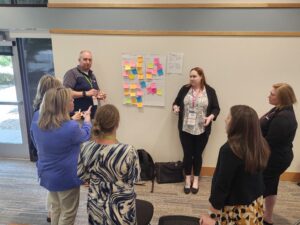Asked to envision new career pathways for their most in-demand industries, attendees at a Grand Junction summit this week went beyond just educational partnerships, saying they need funding, regulatory reform and budgeting consistency to stabilize prominent sectors.
Monday’s Opportunity Now Regional Talent Summit at the Mesa County Workforce Center — the fourth of seven such summits authorized across Colorado by a 2024 law backed by the business-led Education to Employment Alliance — was, in some senses, the furthest-reaching in terms of its ambitions. Roughly 100 people from academia, workforce development and the construction, healthcare and early-childhood-education sectors proposed two-and five-year plans that incorporated everything from the need for AI training to community-support campaigns.
Each of the summits will produce short- and medium-term plans for how to boost talent into regionally needed fields — plans involving new curriculum or training that employers, business organizations, educators and workforce-development centers will guide into existence. Gov. Jared Polis has noted these will be industry-led plans, emphasizing that employers are to help guide schools to teaching the most needed skills.
Where attendees at other summits outlined plans ranging from the broad (incorporating durable skills like problem-solving into mechanical education) to specific (instructing cybersecurity students how to get security clearance), Monday’s invitees took a different tact. They discussed not just educational disconnects but government-imposed restrictions that would continue to block key sectors from getting the workforce they need unless big-picture changes accompany new career pathways.
“Being bold and leaning into new ideas”
In some ways, they seemed to be taking the lead of Candace Carnahan, the president/CEO of the regional summit host, the Grand Junction Area Chamber of Commerce, who prodded them to take this opportunity to think big and think comprehensively.
“Today’s not about rehashing the same strategies we have been doing but that haven’t been moving the needle,” Carnahan told the crowd. “Today is about being bold and leaning into new ideas.”

Grand Junction Area Chamber of Commerce President/CEO Candace Carnahan speaks at Monday’s Opportunity Now Regional Talent Summit.
For attendees from the early-childhood-education sector, that boldness emanated from an acknowledgement that while their industry is vital to a functioning economy, daycare and preschool workers do not make enough to generate a stable pipeline of workers. Thus, rather than just thinking about how to attract more learners, they considered how to supplement existing pay levels and how to position the industry as a potential springboard for people wanting a career in education.
Industry leaders who too often spend scholarship resources training workers only to lose them to the higher-paying restaurant and retail sectors need to articulate better how people can move up in the sector or move onto other educational fields, attendees said. This can be done by creating more quick but quality credentials to enter the field, offering stackable credentials that let workers tout their experience rather than just their degrees and working with school districts to develop pathways into elementary teaching jobs.
A plea for state help with pay
Even then, though, attendees admitted that the lower levels of pay — required to keep childcare affordable for everyone — present a major barrier to growing talent pipelines and must be addressed on their own. To solve this, sector leaders must organize and advocate for consistent and sustainable legislatively mandated regional funding to supplement market-based pay because childcare offers a societal economic good of returning otherwise homebound parents to the workforce, they decided.
“The root cause (of worker shortages) to me is the pay,” said Stephanie Bivins, director at the Mesa County Partnership for Children & Families. “I think people would stay if it’s an industry that they could afford.”

Stephanie Bivins and Curtis Englehart listen to a speaker at Monday’s Opportunity Now Regional Talent Summit in Grand Junction.
Healthcare leaders also pinpointed pay as a stumbling block, but in a different way, particularly for behavioral health professionals like mental-health counselors — identified as the second-most-needed pathway among sector attendees. The lengthy process of being credentialed by the state forces months-long periods where people must go without pay, leading some of them to look toward other jobs, industry leaders said.
Can regulatory relief boost career pathways?
In addition to speeding up credentialing for reimbursement, Colorado must let mental-health professionals in training get supervision hours that are needed before professional certification in a faster way, said Korrey Klein, CEO of Family Health West, a 25-bed Fruita hospital. That could be done, for example, by on-the-job supervision that would let people earn pay while working and could permit healthcare centers to streamline the pathway from learning into working, particularly in short-staffed rural areas, he said.
“We have been so focused in healthcare making sure the patient is safe that we have probably over-credentialed,” Klein said . “I think there’s a regulatory or legislative piece as well. It’s not as simple as marrying industry to education and then we are done.”

Family Health West CEO Korrey Klein leads a discussion on how to produce more mental-health counselors at Monday’s Opportunity Now Regional Talent Summit in Grand Junction.
Attendees in that field suggested a two-year plan that would create more career pathway solutions specifically involving employers in smaller-population areas who could tie into high-school and college populations to maintain local talent. The five-year plan would involve developing more shared-site clinical models so that training portion could be split between multiple employers who could take advantage of work-based learning, as well as tying state training funds to improvements in mental-health outcomes.
AI, budget certainty needed in construction
For construction leaders at the summit, the fear is that they won’t be able to train the next generation of students quickly enough to replace the wave of professionals who are aging out of being able to work in the field, no matter how many pathways they develop. Thus, they contemplated ways to keep existing construction workers in the field longer while making the career more interesting to younger workers.
One way of doing that, attendees suggested, would be to have educators work with industry leaders to teach them about how to use AI to supplement their work and lighten some of their loads. In addition, teaching longtime employers how to use new technology like exoskeletons that will allow older workers to lift more without getting hurt would show new-to-the-equipment employers the return on investment such tools could create and allow them to offer more interesting job routes to learners.
But because construction is a sector that often is dependent on government contracts, particularly for road construction, the state also should work with industry leaders to predict budgets 10 years out, which would let industry leaders know how many workers they need to train, said Mark Gould Jr., president/COO of Gould Construction. That forbearance, combined with a commitment to change essential employment, emissions and equipment rules no more than every five years would allow the industry and the state to work as partners and plan out the appropriate number of career pathways, he said.
What comes next in development of pathways

Mark Gould Jr. of Gould Construction offers suggestions at Monday’s Opportunity Now Regional Talent Summit in Grand Junction.
“Without turning them into indentured servants, we need to make sure our workforce can work longer,” Gould said. “There’s just not enough people coming into the pipeline.”
Still, sector leaders identified a goal of boosting the pipeline of trained professionals by 10% to 30% by coordinating with public partners to understand needs and then working to establish more training programs particularly in regional high schools. A short-term recommendation involved upscaling a Colorado River BOCES program in which classes of students build tiny homes to sell to local professionals, allowing them skills that they need to get summer and post-graduation jobs and using the proceeds to sustain the program.
State leaders will put together more in-depth recommendations for two- and five-year programs and then reconnect with summit participants to get further input. The recommendations for each summit will be included in the Colorado Talent Pipeline Report that comes out in December.
